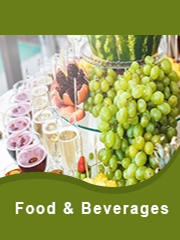TOP CATEGORY: Chemicals & Materials | Life Sciences | Banking & Finance | ICT Media

Download Report PDF Instantly
Report overview
Natural vegetable coloring refers to pigments derived from plant-based sources such as vegetables, fruits, herbs, and other botanicals to impart color to food, beverages, and other consumer products. These natural colorants serve as alternatives to synthetic dyes, appealing to consumers looking for clean-label and non-artificial ingredients. Popular vegetable-based colorants include carotenoids from carrots, anthocyanins from red cabbage, and chlorophyll from spinach.
The global natural vegetable coloring market was valued at approximately USD 1,696 million in 2023 and is projected to grow significantly, reaching USD 3,224.51 million by 2032, with a CAGR of 7.40% during the forecast period.
In North America, the market size stood at USD 499.77 million in 2023, with an anticipated CAGR of 6.34% through 2032. The market's rapid expansion is fueled by increasing consumer demand for clean-label products and stringent regulations against synthetic dyes in food and beverages.
Consumer Demand for Clean Labels – Growing awareness of food safety and health concerns has driven the demand for natural and transparent ingredient lists.
Regulatory Support – Governments worldwide are imposing restrictions on artificial dyes, encouraging manufacturers to adopt natural alternatives.
Rising Popularity of Plant-Based Diets – The surge in plant-based food products has amplified the demand for natural coloring agents.
Innovation in Extraction Technologies – Advances in extraction methods enhance the efficiency and quality of natural colorants.
Restraints
High Production Costs – Extracting natural pigments requires extensive processing, making them more expensive than synthetic alternatives.
Limited Stability and Shelf Life – Natural colorants tend to degrade faster under heat and light exposure, limiting their applicability.
Supply Chain Challenges – Seasonal availability of raw materials can disrupt production and impact pricing.
Opportunities
Expansion in Emerging Markets – Growing economies in Asia-Pacific and Latin America offer significant growth potential for natural colorants.
R&D in Natural Pigment Stability – Improved formulation techniques can enhance color stability and broaden application ranges.
Increased Applications in Non-Food Sectors – Natural vegetable colorants are being increasingly used in cosmetics, pharmaceuticals, and textiles.
Challenges
Regulatory Compliance Variability – Different countries have varying approval processes and regulatory requirements for natural colorants.
Competition from Alternative Natural Color Sources – Other natural pigments derived from algae, fungi, and microbial sources compete with vegetable-based colorants.
North America
The North American market is driven by stringent FDA regulations favoring natural ingredients and increasing demand for organic products. The U.S. leads in market share, followed by Canada and Mexico.
Europe
Europe has one of the most stringent regulations on synthetic food colorants, driving high adoption of natural alternatives. The region also benefits from a well-established organic food industry.
Asia-Pacific
With rapid urbanization and evolving dietary preferences, countries like China, India, and Japan are seeing substantial growth in the natural vegetable coloring market.
South America
Brazil and Argentina dominate the market due to strong agricultural outputs and rising consumer awareness regarding artificial food additives.
Middle East & Africa
While still a developing market, MEA is witnessing an increasing demand for clean-label products, particularly in high-income regions such as the UAE and Saudi Arabia.
Major players in the natural vegetable coloring market include:
CHRHANSEN – Leading supplier with innovative natural pigment solutions.
Sensient – Known for high-quality natural and organic food colorants.
Synthite – Specializes in natural extracts for food and beverages.
Plant Lipids – Focuses on sustainable and plant-based color solutions.
DSM & BASF – Prominent in carotenoid production for various applications.
Zeaxanthin – Derived from green vegetables, used in food and nutraceuticals.
Capsanthin – Extracted from red peppers, popular in spice blends and sauces.
Carotene – Obtained from carrots, essential for dairy and beverage applications.
Others – Includes anthocyanins, chlorophylls, and betalains from various sources.
Food Industry – The largest segment, driven by demand in bakery, dairy, and beverages.
Feed Industry – Growing applications in poultry and aquaculture feed for pigmentation.
Others – Includes pharmaceuticals, cosmetics, and textile applications.
The market is highly competitive, with key players including:
1 What is the current market size of the Natural Vegetable Coloring market?
As of 2023, the market size is valued at USD 1,696 million and is expected to reach USD 3,224.51 million by 2032.
2 Which are the key companies operating in the Natural Vegetable Coloring market?
Major players include CHRHANSEN, Sensient, Synthite, Plant Lipids, BASF, DSM, and Naturex, among others.
3 What are the key growth drivers in the Natural Vegetable Coloring market?
Consumer demand for clean labels, regulatory restrictions on synthetic dyes, and growth in plant-based foods are key drivers.
4 Which regions dominate the Natural Vegetable Coloring market?
North America, Europe, and Asia-Pacific are the leading regions, with significant growth potential in South America and MEA.
5 What are the emerging trends in the Natural Vegetable Coloring market?
Emerging trends include advanced extraction technologies, expansion in non-food applications, and rising demand for plant-based products.